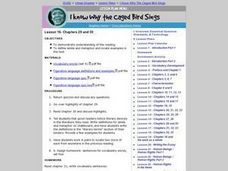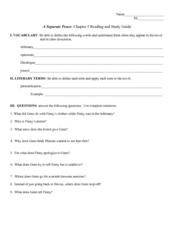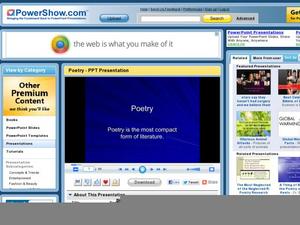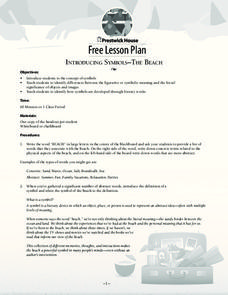Curated OER
Poetry Notes
Break this presentation into two or three days so as not to overwhelm your kids. Fifty-four slides is a lot of slides, but the PowerShow is well-organized, and terms are defined clearly and illustrated in examples provided. A general...
Curated OER
Figurative Language
Play a figurative language game! Starting with a review of terms, this presentation quickly launches into a quiz game with hyper-linked answers. Simply click an answer to find out if it's wrong or right. The option to try again is always...
Core Knowledge Foundation
Unit 7: Poetry
Over the course of a 12-lesson language arts unit, young scholars analyze a variety of poems taking a close look at figurative language and tone. They learn to compare and contrast, improve comprehension, and identify settings. To...
Curated OER
I Know Why the Caged Bird Sings: Chapters 29, 30
Students complete literary analysis activities for the Maya Angelou's I Know Why the Caged Bird Sings. In this novel analysis lesson, students read chapters 29 and 30 of the novel and complete chapter quizzes. Students write...
Curated OER
A Separate Peace: Chapter 5 Reading and Study Guide
In this study guide for chapter 5 of A Separate Peace, students complete 4 vocabulary definitions, 2 literary term definitions and 9 short answer questions. Finally, students respond to a given passage.
Curated OER
Vocabulary Bookmark
In this literary devices worksheet, learners use the bookmark format to help them when reading and looking for literary devices. Students define the devices and use the questions to help them find the devices within the text.
Curated OER
"Black Boy"
Students read a series of sentences and decide what literary term is being shown. They also discuss a novel about prejudice.
Curated OER
Lots of Lessons from Aesop
Aesop’s Fables offer young learners an opportunity to study figurative language. After reviewing theme, simile, alliteration, and metaphor, model for your pupils how to identify examples of these devices in the fable. Class members then...
Curated OER
Poetry: The Most Compact Form of Literature
Introducing or need to review literary devices and terms for a study of poetry? Though text heavy, the explanations and examples of key poetic devices will provide learners with the vocabulary they need to discuss and craft poems.
Curated OER
Deciphering the Mechanics of Poetry
After a review of poetic terms, groups are given an object and they create a poem using a simile, a metaphor, internal rhyme, end rhyme, alliteration, and personification. Groups then exchange objects and repeat the process. Consider...
Premier Literacy
Point of View
Incorporate technology into a literature lesson with an innovative language arts lesson. Middle schoolers read an electronic version of original stories or fairy tales, and after determining the point of view, rewrite the tale from...
Curated OER
Exploring Color Vocabulary
Students explore color terms and related meanings and metaphors in cultural and literary contexts. They use the main colors to explore synonymous color terms and related metaphorical meanings of color words. Students recognize the...
Curated OER
Macbeth: Quotations
In this Macbeth activity, learners read passages from Macbeth and answer the prompts for each one. Prompts include identifying the speaker, describing the context of the quote, and explaining the significance of one of five literary...
Curated OER
Deciphering the Mechanics of Poetry
Eighth graders study poetic devices and use them in their own writing and apply them when reading poetry. In groups, they describe an item using poetic devices.
Curated OER
Similes and Metaphors
What is a simile? What is a metaphor? How are both of these different? First, discuss the difference between the two terms, and then have your emerging writers practice identifying sentences that use either literary device. They are also...
Curated OER
History Personified
Learners explore historical events by writing a research paper using personification.
Curated OER
Imagine That! Analyzing Imagery
Poems by O. Henry, Marion Dane Bauer, Monty Roberts, and Langston Hughes provide the text for a study of symbolism, hyperbole, and imagery. Employing the “think-pair-share” strategy learners generate definitions of these terms and locate...
Curated OER
Sarcasm
Learners often regard sarcasm as a "you know it when you see it" language phenomenon, leading to confusing tone and humor in student writing. This presentation not only defines sarcasm (and irony) in plain terms, it also provides many...
Curated OER
Figurative Language: Similes
How does one identify a simile, and why is it important to understand what they are? Here's a very basic review. This short presentation defines the term, provides examples, and gives learners a chance to identify which two things are...
Curated OER
Language Play
Introduce your scholars to onomatopoeia and alliteration using a language elements worksheet. They examine six sound words and match them to four pictures. Next, learners read two examples of alliteration and write one of their own. They...
Curated OER
Ready, Set, Tech (Primp Up Your Poems: Literary Devices)
High schoolers study literary devices used in poetry. They gain access to a specific Internet poetry site that provides a step-by-step guide on how to write a poem. They each write a poem and then exchange it with others in a group for...
Curated OER
Pink Floyd and the Carpe Diem Theme
Students listen to Pink Floyd's "Time" in order to apply the theme of carpe diem to other works of literature and to their own life.
Prestwick House
Introducing Symbols–The Beach
Looking for a way to introduce class members to the concept of symbolism and multiple levels of meaning? Readers examine two different passages about the beach and consider how the writers use concrete objects, and places to...
PBS
Using Video to Create Setting and Mood
Writers have long used words, the sound of words, and the images created by their words to describe the setting and establish the mood of their stories. To gain a more in depth understanding of how settings can be used to develop a...

























